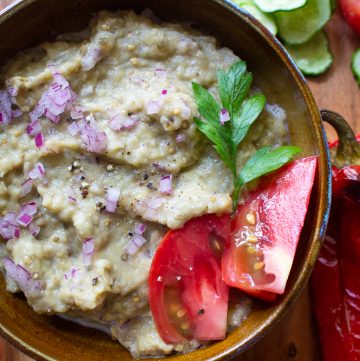
Romanian Eggplant Dip (Salata De Vinete)
Romanian Eggplant Salad (Salata de Vinete) is an appetizer that's considered a staple in Romanian cuisine, both for every day eats and fancy company dinners.For those measuring, the eggplant/onion mixture serves as veggie portion, and the mayo/oil serves as fat. This whole recipe makes about 2 portions.
Ingredients
Veggies
- 1 eggplant, roasted (see notes, any of those methods work fine)
- 1/4-1/3 cup diced sweet onion (Vidalia is how I grew up eating it, but I especially love red onion)
Fat
- 1 oz mayo (I love Vegenaise) or a drizzle of good quality olive oil
Condiments
- pinch salt, or to taste
Instructions
First, Prepare the Eggplant
- Consider you’ve already roasted the eggplant with any of the methods I mentioned above, and let it cool for 10 minutes.
- Holding on to the stem with one hand, gently peel back the peel with your other hand.
- Cut the eggplant in half and quarters, lengthwise, and place it either on a wooden board (as my mother does), leaned at a 45 degree angle over a bowl to release the juices. Alternatively, I place the eggplant over a colander which is over a bowl, and let the juices flow out this way.
- Let the eggplant drain for about an hour or so.
- Place the eggplant in a food processor (or simply chop with a knife, as my mother does).
- Note: if you decide to roast more than one eggplant (I often do 3-5!), these freeze really well. Feel free to freeze them after the draining stage, and then make them throughout the winter as a lovely salad over buckwheat bread. Yum!
Assemble the Salad
- Add oil/mayo, salt, and sweet onion, and taste for seasoning.
- You will want to add the onion right before eating, as it doesn’t keep well in the salad. Alternatively, just add the mayo/oil to the eggplant, refrigerate, and add the onion for when you’re ready to eat it.
Notes
METHODS FOR CHARRING/COOKING EGGPLANT: Method 1, Directly on the Stovetop: I remember my mother putting an eggplant directly on the burner and turning it over and over until it blackens. You have to be very diligent with this, as it releases a lot of juices and splashes in the flame. It’s sort of a mess, but also fun if you’re adventurous! Then follow Steps 4, 5, 6 below. Method 2, Charring it in a pan: Later on in my childhood, I’d see her place the eggplant on a frying pan and turn it over and over until the skin blackens. I believe a cast iron pan would work the best for this, but you can use anything you have. Then follow Steps 4, 5, 6 below. Method 3, Roasting it in the oven (my favorite method):
- First step: Pierce the eggplant many times with a fork (Since steam has to escape as it cooks, the eggplant exploded in the oven when I omitted this step ~ not fun!)
- Second step: Roast at 375 degrees for about 30-60 minutes (the timing depends on how thick the eggplants are, so use your judgment).
- Third step: Turn the eggplants over on various sides throughout the cooking process so they cook evenly and the skin darkens on each edge.
- Fourth Step: The eggplant is done when it is soft to the touch, and the shape is shrunken in a bit (which means the middle is also done).
- Fifth Step: Let cool on a cutting board for about 10 minutes. It will still be warm, but easier to handle. Follow the instructions in the recipe below beyond this point.